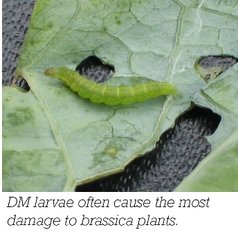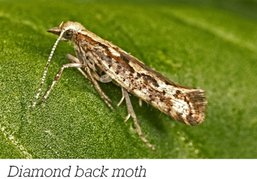Diamondback moth
Plutella xylostella
Diamondback moth (DM) occurs throughout NZ, often in association with white butterfly.
Identification
Adult DM is a small, slender, grey insect with a wingspan of 7-10 mm. When the wings are folded along the body a line of yellow diamond-shaped spots are visible, hence the name.
Adults are nocturnal in habit, and the female lays up to 100 light yellow oval eggs, usually on the underside of leaves.
On hatching, the small (2 mm long) larvae are pale green with a dark head. Fully grown larvae vary in colour, but are mostly green and 7-9 mm long. They are widest in the middle, and taper slightly towards each end.
DM pupae are up to 7 mm long and are pale green but change to pale creamy-brown colouring with darker markings. These are enclosed in loosely woven cocoons often found on the underside of leaves in the crop.
Larvae cause the most damage by feeding on the leaves, with young larvae boring into the leaf and feeding on the internal leaf tissue, which appears as white markings on the leaves. As they grow they emerge to feed on the underside of leaves, with damage appearing as holes in the leaf.

It can be hard to distinguish between DM larvae and white butterfly caterpillars, with the only major difference being in their behaviour when disturbed. DM larvae tend to drop off leaves on a thread when disturbed, while white butterfly caterpillars tend to rear up and be quite aggressive. As DM tend to drop off the leaves onto the soil surface, care must be taken when inspecting crops to ensure the full extent of infestation is recognised.

Prevention and management
Forage crops are usually attacked by DM through the summer, with damage becoming more noticeable in autumn when the pest population is high and the plants are growing more slowly.
Many brassica crops can compensate for early damage, and if left untreated DM can be minimised by natural enemies. Two parasitoid wasps have been introduced into NZ and have become established as active biological control agents.
Monitor crops on a weekly basis. Insecticide application can achieve good success in controlling DM.

